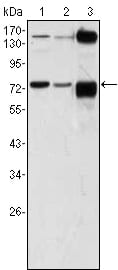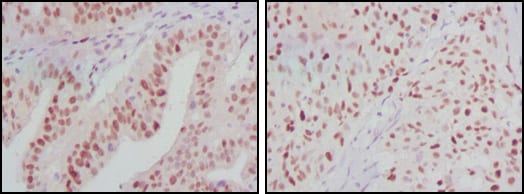图片
 |
Western blot analysis using ATP2C1 mouse mAb against A431 (1), Hela (2) and HEK293 (3) cell lysate. |
 |
Immunohistochemical analysis of paraffin-embedded human ovarian cancer (left) and breast cancer (right) tissues using ATP2C1 mouse mAb with DAB staining. |
产品详情
ATP2C1, also known as PMR1, it belongs to the family of P-type cation transport ATPases. This magnesium-dependent enzyme catalyzes the hydrolysis of ATP coupled with the transport of the calcium. The human homologue, ATP2C1 (also designated SPLA in rat), also regulates the transport of calcium in the Golgi complex and is related to other P-type ATPases family members, such as the sarco(endo)plasmic calcium ATPase (SERCA) and the plasma membrane calcium ATPase (PCMA). ATP2C1 is a transmembrane protein that exists as two splice variants, which vary by 20 amino acids. Defects in ATP2C1 cause Hailey-Hailey disease, which is an autosomal dominant disorder that is characterized by blisters and erosions of the skin. These findings provide further evidence that PMR1 plays a key role in maintaining the integrity of the epidermis by controlling intracellular calcium signaling.



 收藏
收藏


 电话咨询
电话咨询
 在线咨询
在线咨询
 QQ
QQ
 二维码
二维码
 扫码二维码
扫码二维码